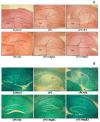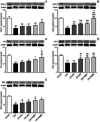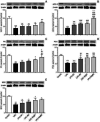Dose-Dependent Effect of a New Biotin Compound in Hippocampal Remyelination in Rats
- PMID: 39821844
- PMCID: PMC11953097
- DOI: 10.1007/s12035-025-04686-y
Dose-Dependent Effect of a New Biotin Compound in Hippocampal Remyelination in Rats
Abstract
Demyelination is commonly observed in neurodegenerative disorders, including multiple sclerosis (MS). Biotin supplementation is known to stabilize MS progression. To reduce the effective dose of biotin, we synthesized a new and superior form of biotin, a complex of magnesium ionically bound to biotin (MgB) and compared its dose-dependent effect with biotin alone after inducing demyelination using lysolecithin (LPC) in rats. Myelination was assessed using luxol fast blue staining and immunostaining against MBP protein, revealing that the most significant remyelination occurred in the MgB groups. Additionally, both biotin and MgB-treated animals showed dose-dependent improvements in spatial memory. Moreover, we detected a decrease in inflammatory proteins in both treatment groups, which was more prominent in high-dose MgB-treated animals and correlated with decreased expression of NF-κB p65, OP, and MMP-9 proteins. Further analysis of biotin-related proteins demonstrated that both biotin and, notably, MgB reversed the demyelination-dependent reduction of these proteins. Furthermore, biotin, particularly MgB, improved neuronal transmission proteins, Synapsin-1, PSD-93, and PSD-95. Additionally, both treatment groups exhibited increased BDNF, GAP43, and ICAM levels, with significant increments observed in high-dose MgB-treated animals. Increased GFAP, indicative of reactive gliosis, was observed in LPC-treated animals, and this effect was notably reversed by high-dose MgB treatment. The current data emphasize the dose-dependent beneficial effect on the remyelination process. Furthermore, the combination of biotin with Mg resulted in a more potent effect compared to biotin by itself. The strong influence of MgB encourages proof-of-concept studies using MgB in patients with MS.
Keywords: Biotin; Demyelination; Magnesium-biotin; Multiple sclerosis; Remyelination.
© 2025. The Author(s).
Conflict of interest statement
Declarations. Ethics Approval: This study complied with ethical concerns and was approved by the Firat University Animal Research Ethics Committee, Approved number: 257169. Consent to Participate: Not applicable. Consent for Publication: Not applicable. Conflict of Interest: James Komorowski, Sara Perez Ojalvo, and Sarah Sylla are employed by JDS Therapeutics, LLC (Purchase, NY, USA). The other authors declare no conflict of interest.
Figures







References
-
- Sedel F, Bernard D, Mock DM, Tourbah A (2016) Targeting demyelination and virtual hypoxia with high-dose biotin as a treatment for progressive multiple sclerosis. Neuropharmacology 110:644–653. 10.1016/j.neuropharm.2015.08.028 - PubMed
-
- Sedel F, Papeix C, Bellanger A, Touitou V, Lebrun-Frenay C, Galanaud D, Gout O, Lyon-Caen O et al (2015) High doses of biotin in chronic progressive multiple sclerosis: a pilot study. Mult Scler Relat Disord 4:159–169. 10.1016/j.msard.2015.01.005 - PubMed
-
- Ludwin SK, Rao VT, Moore CS, Antel JP (2016) Astrocytes in multiple sclerosis. Mult Scler J 22:1114–1124. 10.1177/1352458516643396 - PubMed
-
- Stadelmann C, Wegner C, Brück W (2011) Inflammation, demyelination, and degeneration - recent insights from MS pathology. Biochim Biophys Acta-Mol Basis Dis 1812:275–282. 10.1016/j.bbadis.2010.07.007 - PubMed
-
- Ayers MM, Hazelwood LJ, Catmull DV, Wang D, McKormack Q, Bernard CC, Orian JM (2004) Early glial responses in murine models of multiple sclerosis. Neurochem Int 45:409–419. 10.1016/j.neuint.2003.08.018 - PubMed
MeSH terms
Substances
LinkOut - more resources
Full Text Sources
Miscellaneous

